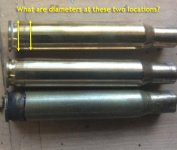According to SAAMI, the minimum chamber diameter 0.200" in front of the head is 0.4708". He is not wider than that, so we could expect it to be that wide over the pressure ring. The question is whether the head itself is actually that big, and I can't tell from the photos that include the caliper exactly where it is landing.
Let's get a difference.
Jwilson, can you use the thinner tips of your caliper jaws to pick up diameters at the two locations shown below? Use your thumb and index finger to close the jaws by pinching them closed. This is less prone to causing flexing of the jaw at its beam way, where the measurement is made. You want to wipe off the jaws and pinch them for setting zero first, to keep everything on the same basis.
The idea is to get the head just immediately in front of the extractor groove relief angle and just at or immediately above where the crack forms (find the widest diameter, wherever that is without including brass actually blown open into a crack).

What Tobnpr is suggesting is getting a plastic gauging material behind a case or, if you have one, a 30-06 GO gauge. When you close the bolt on it that will thin it to the thickness needed to push the shoulder of the gauge or case all the way against the shoulder of the chamber. When you remove it, then it will retain that thickness so you can measure it with your caliper or, better yet, your new micrometer. This thickness will be the extra headspace that exists beyond the length needed by the case. It should be within about a thousandth or two of the difference you get with the case comparator when you measure new brass before and after, but it doesn't spring back, as brass does, so it's a little more precise. The best way to get this is using a GO gauge, so you get an exact number. A GO gauge is also something you can zero your case comparator on to get absolute difference measurements.
One other thing it occurs to me to check is if your bolt lugs are making even contact with the receiver lugs. Color the rear surfaces of the bolt lugs with a Magic Marker and open and close the bolt a few times to see if that marks both of them equally. If it only marks on, then the gun will have a pressure threshold above which it pushes the metal back into contact on both sides. This has the same effect as growing the chamber a little. It's not very likely to be enough distance to cause the problem, but worth checking. Some commercial ammunition is not loaded to very high pressures, and the difference between your pressure and theirs could still have an effect.
Let us know if not-crimping seems to make any difference.


